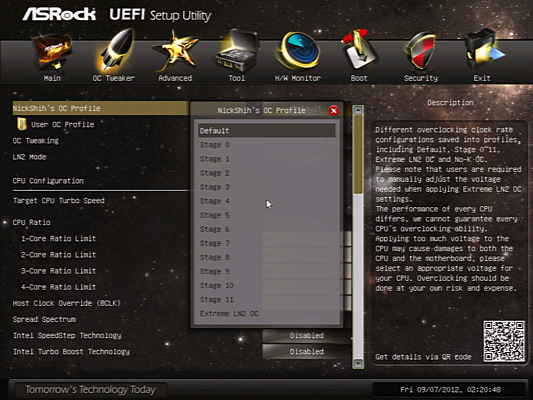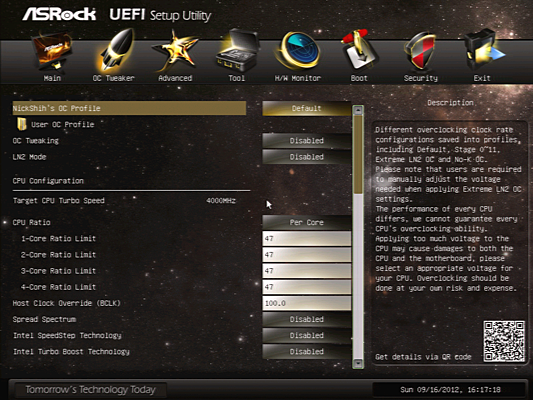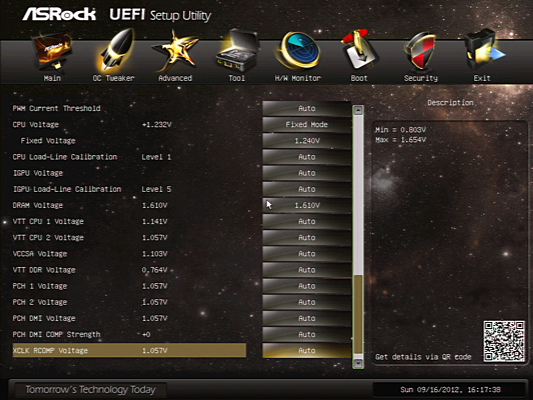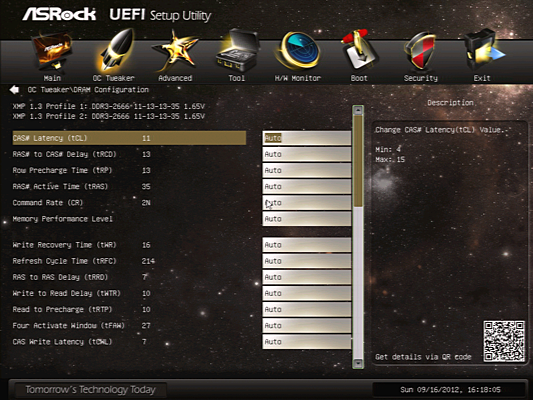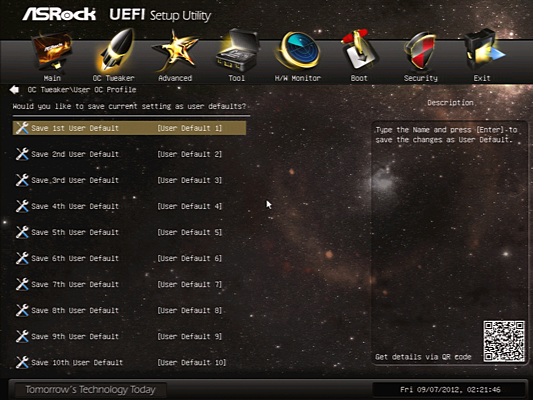Six $220-280 Z77 Express-Based Motherboards, Reviewed
Expanded graphics card support, enhanced on-board features that include Thunderbolt on some models, and more-robust voltage control are all good reasons to consider paying a little extra for a higher-end motherboard. Today we examine five top choices.
Z77 OC Formula Firmware
The Z77 OC Formula employs ASRock’s familiar overclocking presets. However, the firm hired a reputable overclocking guru to develop this board’s settings beyond those of previously-reviewed models. The top overclock, Stage 11, uses a 50x CPU multiplier and 1.45 V. Each step down drops around 1x from the multiplier and 0.05 V from the CPU core.
Generic overclocking profiles are designed to support a broad range of CPU samples, but some cores are inherently better than average. We were able to reach 4.70 GHz at 1.25 V, though the actual setting needed to get us that voltage was 1.240 V.
Most disconcerting was that we needed to set our DRAM to 1.61 V in order to reach its rated 1.65V setting. We’ve noticed that motherboards have been getting better at memory overclocking, and that voltage creep appears to be part of this trend. Even at the lower voltage setting, we were able to slightly exceed our memory’s DDR3-2666 rating.
A full set of primary and secondary memory timings are available for tweaking, along with clock skew controls.
The most unusual setting we found in the Z77 OC Formula UEFI was ASRock Dehumidifier. This feature simply wakes the computer from S3/S4 states periodically to warm the hardware up and prevent the collection of moisture, with user-defined waking and sleeping times.
The Z77 OC Formula provides ten storage registers for custom BIOS configurations, allowing users to experiment with various overclocking techniques and return to previous versions. Though its competitors offer similar functionality, we’ve never seen (nor needed) this many user profiles.
Get Tom's Hardware's best news and in-depth reviews, straight to your inbox.
Current page: Z77 OC Formula Firmware
Prev Page Z77 OC Formula Software Next Page Asus Sabertooth Z77-
roberta As u have reviewed SIX (6) motherboards, the article's title should be:Reply
"Six $220-280 Z77 Express-Based Motherboards, Reviewed" -
mayankleoboy1 No SATA and USB tests ? data transfer speed differences will typically be noticable in everyday usage.Reply
Also, the time taken to show the windows loading screen/ BIOS page.. -
admit it.Reply
you really liked the black/grey dimms and PCI slots of the gigabyte better than the blue/black of the MSI! -
Crashman robertaAs u have reviewed SIX (6) motherboards, the article's title should be:"Six $220-280 Z77 Express-Based Motherboards, Reviewed"Let's see what the article says:ReplyThe one motherboard in today’s line-up with a 48-lane PCIe 3.0 bridge is ECS’ Golden Z77H2-AX. Unfortunately, this platform climbed $40 beyond the budget limit of today’s round-up in the time we've been reviewing it. We're tired of seeing board vendors playing pricing games based on our review schedule (this isn't the first time we're seeing a curiously-timed price move). So, since we put the work in to review ECS' submission, we're including our already-gathered data and simply withholding the board from any award candidacy.
mayankleoboy1No SATA and USB tests ? data transfer speed differences will typically be noticable in everyday usage.Also, the time taken to show the windows loading screen/ BIOS page..Would have covered windows load time except that it wasn't markedly different. That is, after disabling empty SATA controllers. If you count the time that it takes to get the "No Device Found" error on boards that have extra SATA controllers, you're penalizing a board for having more features.
Andrew Ku tests drive controllers. I'm trying to get him to "write the book" on controller performance, since dozens of boards use only a few different controllers. As for testing things like Z77 controller performance on board A vs Z77 controller performance on board B, it's a waste of time unless something is broken. So the article looked for "broken stuff". See the red bar on the first chart:
http://www.tomshardware.com/reviews/z77x-up5-th-z77a-gd80-z77-oc-formula,3305-22.html
With nothing broken, there's no excuse to test the Z77 controller six times. Back to me begging Andrew Ku for a comprehensive comparison of every SATA controller currently available on mainstream-brand enthusiast boards.
-
JeanLuc Arghh! Why the hell are you overclocking the base clock on Z77!! That will most likely cause permanent damage to your CPU.Reply -
You left out a key aspect for overclockers which is vcore offset.Reply
This allows ocer's to achieve higher overclocks while still retaining the power saving functions, instead of being forced to either reduce the overclock, or be forced to run high voltage 24/7.
MSI doesn't have this key feature. -
Onus I would think that the Sabertooth's five year warranty merits at least a mention in any value conclusion.Reply
-
luciferano JeanLucArghh! Why the hell are you overclocking the base clock on Z77!! That will most likely cause permanent damage to your CPU.Reply
Overclocking the BLCK is very unlikely to cause any damage, it's just likely to not give much of a stable overclock. -
Crashman jtt283I would think that the Sabertooth's five year warranty merits at least a mention in any value conclusion.I actually missed that, having checked the lesser brands just to make sure those still had their three year warranty. Will add it.Reply
